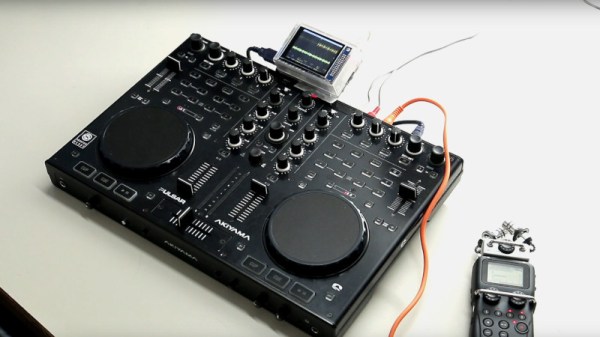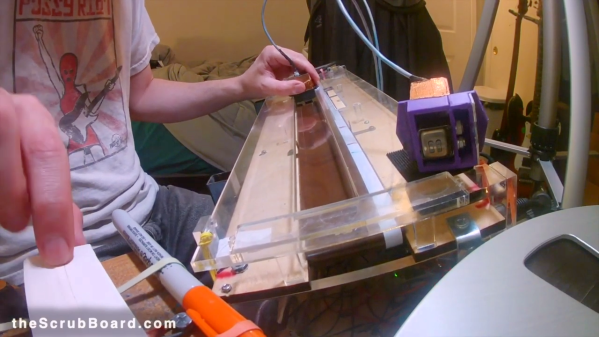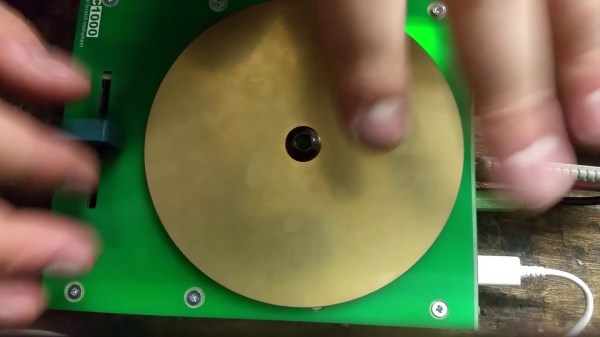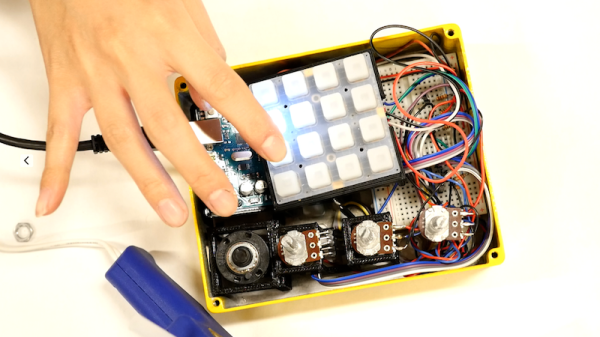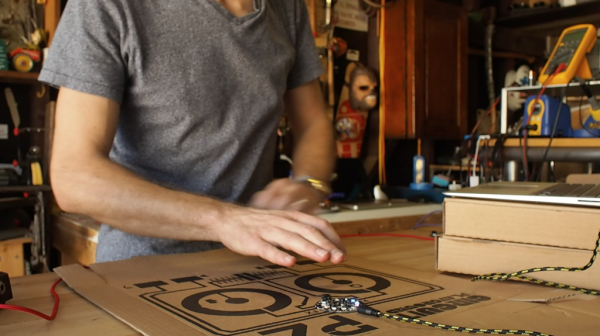Looks like the Simpsons had it right again, now that an Australian radio station has been caught using an AI-generated DJ for their midday slot. Station CADA, a Sydney-based broadcaster that’s part of the Australian Radio Network, revealed that “Workdays with Thy” isn’t actually hosted by a person; rather, “Thy” is a generative AI text-to-speech system that has been on the air since November. An actual employee of the ARN finance department was used for Thy’s voice model and her headshot, which adds a bit to the creepy factor.
dj23 Articles
DJing Without The Truckload Of Equipment; Secret Ingredient Is Raspberry Pi
There is a romance to notions of a byegone age of DJing — driving a pair of Technics 1200s dwarfed on either side by the stacks, pumping techno bass through the laser-tinged darkness into a hungry crowd. Even if the reality of early evening Saturday wedding parties playing inoffensive crooners for the 50-somethings didn’t really live up to it.
The trouble with DJing old-style was that it required extensive logistics to shift all that equipment not to mention a record collection, so the modern DJ for whom everything has gone digital is truly lucky in the scale of their operation. For some people even that is too much to carry, and [Dennisdebel] has minimised a DJ rig to the next level, by running the popular Mixxx DJing software on a Raspberry Pi hooked up to his DJ controller. You can see the result in the video below the break.
This is more of a HOWTO for installing a set of software packages on the Pi to achieve an aim rather than a special hardware hack, but as he points out the interest lies in regaining control of the process. The DJ space is dominated by commercial offerings increasingly laden with DRM and proprietary cloud offerings, so this represents a means of taking back control of the process. If it’s not hacky enough, you can always add a home-made DJ mixing station.
Continue reading “DJing Without The Truckload Of Equipment; Secret Ingredient Is Raspberry Pi”
DJ Scratches Out Club Music With Tape, Not Turntables
It goes without saying that not everyone has the same taste in music, and what sounds amazing to one person will be the next person’s noise. But even if you’re not into hip-hop and the whole DJ scene, it’s hard not to be impressed with what [Jeremy Bell] has done here with his homemade tape loop “scratching” rig.
Most people have probably seen a DJ in a club using dual turntables to scratch or “scrub” a vinyl record back and forth to create effects that add to the music. Part musician and part performance artist, DJs and “turntablists” tend to be real crowd-pleasers. [Jeremy]’s “ScrubBoard” uses a loop of 2″ audiotape, the kind recording studios once used for multitrack recordings. The loop is driven across a wide platen by a motor with a foot pedal control, which he can use to quickly reverse the direction of travel and control the speed of the tape. A pair of playback heads are wired into the amplifier and can be positioned anywhere on the sometimes moving, sometimes stationary tape. The sounds he can create are rhythmic, percussive, and at times frenetic, but they’re always interesting. Check it out in action in the video below.
This version of the ScrubBoard is far from the first [Jeremy] has built. You may recall his first prototype from our coverage in 2014; that one used just a few feet of 1/4″ tape fixed to a board. He was still able to get some great sounds from it, but this version should really change things for him.
Continue reading “DJ Scratches Out Club Music With Tape, Not Turntables”
Junkbox MIDI
Do you ever peer into the void…of your hardware scrap box? It may be a wonderland of parts with near-infinite potential, and they just need to be assembled and depending on what you hoard, programmed. Access to a laser engraver doesn’t hurt either. The stuff in [Mr. Sobolak]’s bin is cooler than average, at least by Hackaday writer standards. His sound palette project is a wild mixture of interfaces, hardware, channels, and color. There are arcade pushbuttons, slider potentiometers, rotary potentiometers, miniature laser harp, touch piano, and drum pads which earns the title of junk box build extraordinaire.
Under the hood, we find the usual copper tape, wire and solder connecting operators to a Teensy 3.2. In the more esoteric part of the BOM, we find some fancy SoftPots which look like great fun to play. All the code is linked in the Instructable, but there is absolutely no reason to make an exact copy. MIDI is from the 80s and libraries abound for this protocol so the building may be the hardest part of making an interface that fits your character. Some of the techniques in the Instructable may help you, like how to connect a piezo element so it can read something lighter than a wrecking ball or the laser harp roughly the size of your palm.
We are not short of MIDI interfaces if you are thinking of making your own or be truly random.
A Scratch Instrument For Ants
If you think that this scratch instrument looks as though it should be at least… three times larger in order to be useful, you’d be wrong. This mighty pocket-sized instrument can really get the club hopping despite its diminuitive size. Despite that, the quality of the build as well as its use of off-the-shelf components for almost every part means that if you need a small, portable turntable there’s finally one you can build on your own.
[rasteri] built the SC1000 digital scratch instrument as a member of the portabilist scene, focusing on downsizing the equipment needed for a proper DJ setup. This instrument uses as Olimex A13-SOM-256 system-on-module, an ARM microprocessor, and can use a USB stick in order to load beats to the system. The scratch wheel itself uses a magnetic rotary encoder to sense position, and the slider is miniaturized as well.
If you want to learn to scratch good and learn to do other things good too, there’s a demo below showing a demonstration of the instrument, as well as a how-to video on the project page. All of the build files and software are open-source, so it won’t be too difficult to get one for yourself as long as you have some experience printing PCBs. If you need the rest of the equipment for a DJ booth, of course that’s also something you can build.
Meet The Video DJ Machine
Have you ever wanted to perform as a DJ but found the equipment expensive as well as intimidating? Well, your prayers have been answered by [Dror Ayalon] who has designed Nomnom 2. It is an open source, music mixing project that uses up to 16 video clips to give you control of your next hit album.
You are given charge of a physical control panel that has 16 buttons and four knobs. Each button can be used to turn on or off a particular clip while the knobs control the repetition rate, volume, speed and playable length of each track. An Arduino sits under the buttons and is responsible for sending the information to an application that runs in your web browser. The browser app uses the NexusUI library to control playback of the audio clips and bring to life the entire experience.
[Dror Ayalon] has been busy polishing his project and there are some neat videos of him demonstrating it so check out the videos below. The code is available for down from GitHub and the BOM is available at the Hackaday.io project page. The web app can be ported to a desktop app using electron and a PCB can be designed for the controller for future versions.
For now, it is incredible to see hardware and software, come together in such a harmonious fashion. This may be the start of something wonderful but if you are just looking for a way to annoy the neighbors, check out the Midi Musical Siren instead. Continue reading “Meet The Video DJ Machine”
Conductive Paint Turns Pizza Box Into DJ Mixing Station
Conductive paints and inks have been around for quite sometime, and the internet abounds with examples of cool projects you can use them for. They’re well suited to quick and fun prototypes, educational workshops, and temporary toys. But, as cool as conductive paint is, it’s not usually the kind of thing that gets people excited at parties.
Well, until now that is. Adafruit has published a dope guide for building a bomb-diggity DJ mixing station out of a pizza box, conductive paint, and a Circuit Playground board. The guide walks you through how to properly apply the conductive paint (in this case using a stencil to lay it onto a cardboard pizza box), wire it up using the Circuit Playground, and integrate it into popular DJ software.
Sure, your sister’s “professional” DJ boyfriend may scoff at it, but it’ll still let you lay down some boss beats. And, when the bass drops nobody will care that you’re scratching a Domino’s box. Of course, there are other options out there if you want a more permanent solution.


